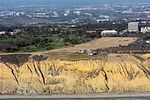Torrey Pines Golf Course

Torrey Pines Golf Course is a 36-hole municipal golf facility on the west coast of the United States, owned by the city of San Diego, California. It sits on the coastal cliffs overlooking the Pacific Ocean in the community of La Jolla, just south of Torrey Pines State Reserve. Opened 65 years ago in 1957, it was built on the site of Camp Callan, a U.S. Army installation during World War II.Torrey Pines has two 18-hole golf courses, North and South, both designed by William F. Bell (son of noted course architect William P. Bell). The South Course was redesigned by Rees Jones in 2001, and is now 7,802 yards (7,134 m) in length from the back tees with par at 72. The North Course was redesigned by Tom Weiskopf in 2016, switching the nines so that the famous ocean views are now enjoyed at the end of the round.Since the late 1960s, Torrey Pines has hosted the PGA Tour's Farmers Insurance Open, originally known as the San Diego Open. During those early editions at Torrey Pines, the course length was under 6,850 yards (6,265 m). Held annually in January or February, the tournament uses both courses for the first two rounds and the South Course for the final two rounds; it was held January 26–29 in 2022 and won by Luke List. The South Course has hosted two U.S. Opens: Tiger Woods won in sudden-death in 2008 after an 18-hole playoff against Rocco Mediate, and Jon Rahm won in 2021. Torrey Pines hosts the San Diego City Amateur Golf Championships every June, and the Junior World Golf Championships every July. Much like Bethpage Black (on Long Island, New York), Torrey Pines has a unique method to ensure continued public access to the course. On weekends, individuals arrive as early as 6 p.m. the prior night to get in line for the first-come, first-served tee times that are given out from sunrise until the first reservations at 7:30 a.m. The course is named for the Torrey Pine, a rare tree that grows in the wild only along this local stretch of the coastline in San Diego County and on Santa Rosa Island. The logo (illustrated: right) features a salt pruned representation of the tree.
Excerpt from the Wikipedia article Torrey Pines Golf Course (License: CC BY-SA 3.0, Authors, Images).Torrey Pines Golf Course
Callan Road, San Diego Torrey Pines
Geographical coordinates (GPS) Address Nearby Places Show on map
Geographical coordinates (GPS)
| Latitude | Longitude |
|---|---|
| N 32.9045 ° | E -117.2454 ° |
Address
Clubhouse
Callan Road
92093 San Diego, Torrey Pines
California, United States
Open on Google Maps





